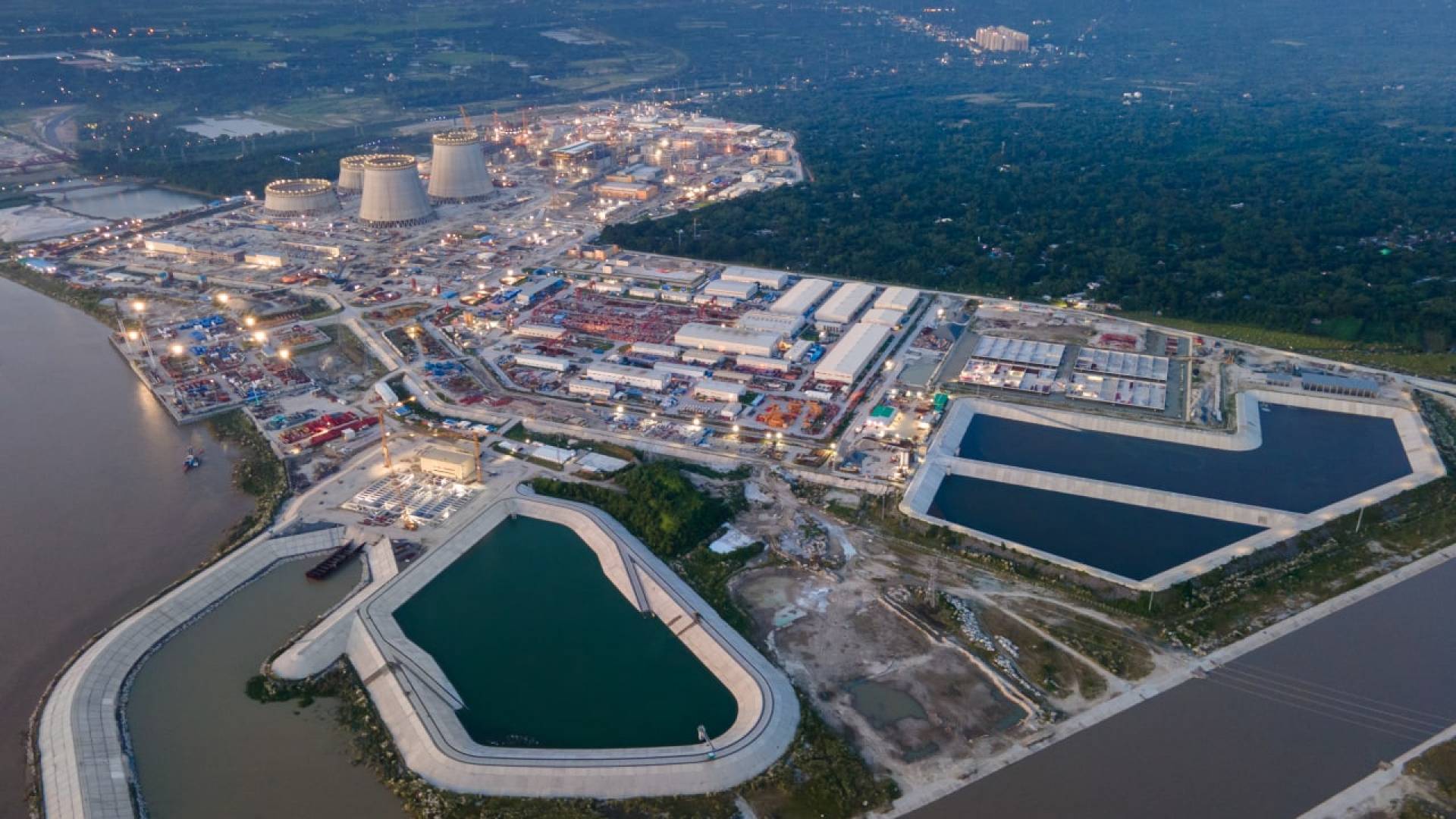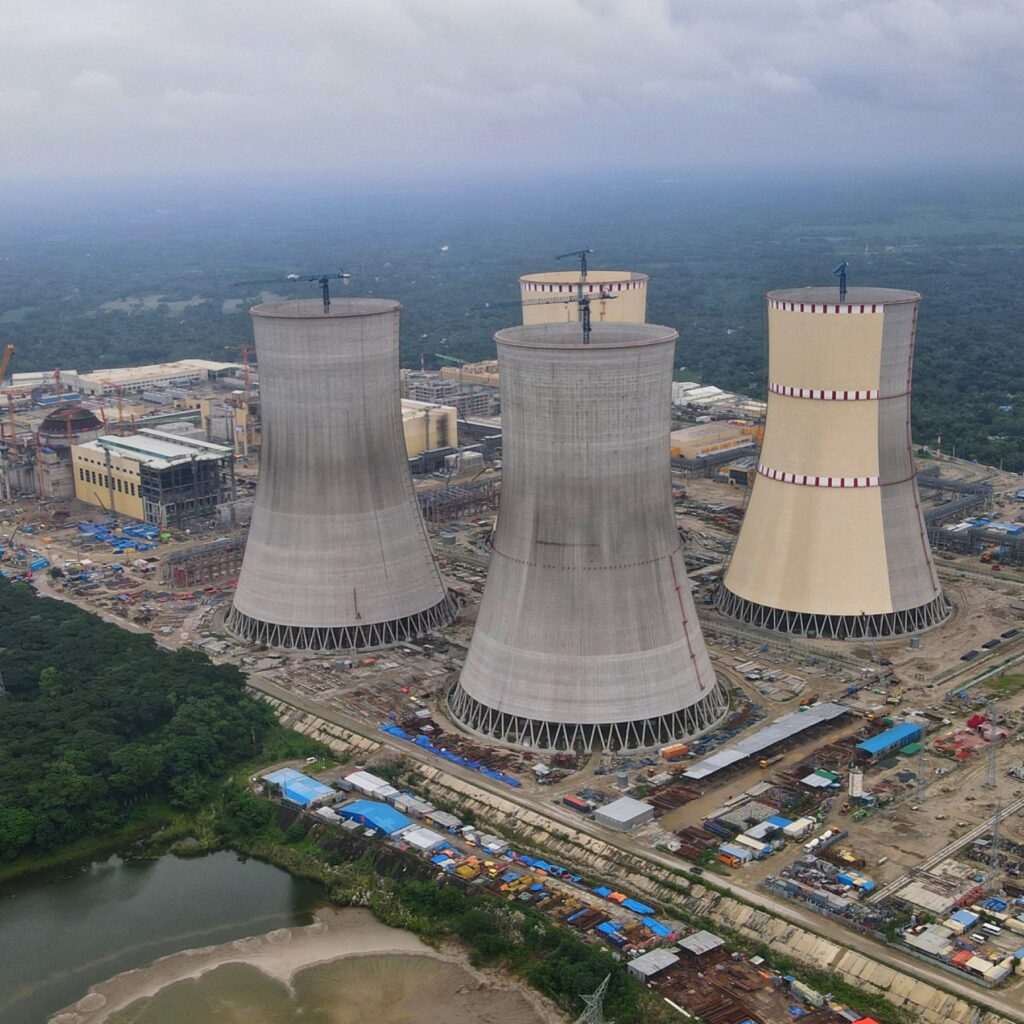The Nuclear Power Plant in Bangladesh is a significant project aimed at generating electricity through nuclear energy. The Ruppur Nuclear Power Plant, located in Bangladesh, is the country’s largest nuclear power plant.
It plays a crucial role in meeting the growing energy demands of Bangladesh and reducing its dependence on fossil fuels. With its advanced technology and safety measures, the plant is expected to provide a reliable and sustainable source of electricity for the country.
This development marks Bangladesh’s entry into the nuclear power sector and contributes to its efforts in achieving energy security and promoting clean energy alternatives.

Credit: m.youtube.com
The Dawn Of Nuclear Energy In Bangladesh
Bangladesh has entered a new era in its energy sector with the introduction of nuclear power. The development of the Rooppur Nuclear Power Plant marks a significant milestone in the country’s quest for sustainable and reliable energy sources.
Rooppur: Bangladesh’s First Nuclear Power Plant
The Rooppur Nuclear Power Plant, situated in the Ishwardi Upazila of Pabna District, is Bangladesh’s inaugural venture into nuclear energy. This power plant, equipped with VVER-1200 reactors, is a testament to the nation’s commitment to embracing advanced and clean energy technologies.
A Milestone In Energy Sector
The initiation of the Rooppur Nuclear Power Plant represents a monumental advancement in Bangladesh’s energy landscape. With a capacity to generate 2,400 megawatts of electricity, this facility is poised to significantly contribute to the country’s power supply and drive economic growth.

Credit: www.iaea.org
Strategic Importance Of Nuclear Energy
Nuclear energy plays a crucial role in meeting the growing energy demands of Bangladesh. The strategic importance of nuclear power plants in the country is evident in various aspects, including energy security, economic impact, and sustainability. Let’s delve into the significance of nuclear energy in Bangladesh.
Energy Security And Diversification
- Nuclear power plants enhance energy security by providing a reliable and consistent source of electricity.
- The diversification of the energy mix through nuclear power reduces the country’s dependence on imported fossil fuels, thus mitigating the impact of global energy price fluctuations.
Economic Impact And Sustainability
- The establishment of nuclear power plants contributes to the creation of employment opportunities and fosters technological advancements in the country.
- It enables Bangladesh to achieve a sustainable and environmentally friendly energy supply, reducing greenhouse gas emissions and combating climate change.
Technical Aspects Of Rooppur Nuclear Power Plant
The technical aspects of the Rooppur Nuclear Power Plant in Bangladesh include advanced safety features, modern reactor technology, and stringent regulatory oversight. The plant aims to provide a reliable and sustainable source of energy for the country’s growing needs, adhering to international standards for nuclear power generation.
Technical Aspects of Rooppur Nuclear Power Plant: Design and Capacity: Rooppur Nuclear Power Plant is a project that has been planned to produce electricity for Bangladesh. The project is being constructed in the Pabna district of Bangladesh. The plant will have two units, each with a capacity of 1200 MW. The design of the plant is based on a pressurized water reactor (PWR) which is a well-known and widely used technology. The PWR design is considered to be one of the safest and most efficient nuclear power plant designs in the world. Safety Features and Protocols: The safety of Rooppur Nuclear Power Plant is the top priority for the Bangladesh Atomic Energy Commission (BAEC). The plant has been designed with multiple safety features to ensure the safe operation of the plant. The plant will have a double containment system which will prevent the release of radioactive materials in case of an accident. In addition, the plant will have an advanced emergency cooling system which will provide cooling to the reactor in case of a loss of coolant accident. The plant will also have a rigorous safety protocol which will be followed by the plant personnel. The safety protocols will include regular safety inspections, maintenance, and emergency response training. The personnel will be trained to respond to any emergency situation and to take appropriate measures to prevent any harm to the surrounding environment and the public. In conclusion, the Rooppur Nuclear Power Plant is a well-designed and well-planned project which will provide much-needed electricity to Bangladesh. The plant is being constructed with the highest safety standards and protocols to ensure the safety of the surrounding environment and the public. With the completion of the project, Bangladesh will become one of the few countries in the world to have a nuclear power plant, and it will be a significant achievement for the country.Collaborations And Support
Building a nuclear power plant is a complex and ambitious endeavor that requires extensive collaborations and support from various partners. Bangladesh has been fortunate to establish international partnerships and receive support from countries like Russia in the development of its nuclear power plant.
International Partnerships
The development of the nuclear power plant in Bangladesh has been made possible through strong international partnerships. These partnerships involve technical, financial, and knowledge-sharing support from countries with expertise in nuclear energy. Collaborations with international partners have played a crucial role in ensuring the successful implementation of the project.
Russia’s Role In Development
Russia has played a significant role in the development of the nuclear power plant in Bangladesh. As a reliable partner, Russia has provided extensive support in areas such as engineering, construction, and technology transfer. The collaboration with Russia has not only accelerated the progress of the project but has also ensured the highest standards of safety and efficiency.
With its vast experience in nuclear energy, Russia has been instrumental in training Bangladeshi professionals and technicians, equipping them with the necessary skills and knowledge to operate and maintain the power plant effectively. This collaboration has not only contributed to the development of the power plant but has also enhanced the capabilities of the Bangladeshi workforce in the nuclear sector.
In addition to technical support, Russia has also facilitated the supply of uranium, a crucial fuel for the nuclear power plant. The delivery of the first shipment of uranium from Russia marked a significant milestone in the project, further strengthening the collaboration between the two countries.
The partnership with Russia is a testament to Bangladesh’s commitment to harnessing nuclear energy for sustainable and reliable power generation. The collaboration has not only brought economic benefits but has also paved the way for future advancements in the country’s energy sector.
Overall, collaborations and support from international partners, particularly Russia, have been instrumental in the successful development of the nuclear power plant in Bangladesh. These partnerships have not only provided technical expertise and financial support but have also strengthened the country’s energy infrastructure and human resource capabilities in the nuclear sector.
Challenges And Solutions
Establishing a nuclear power plant in Bangladesh poses challenges such as ensuring safety, managing nuclear waste, and gaining public acceptance. Solutions include stringent safety measures, advanced waste management techniques, and transparent communication to address public concerns. The successful implementation of these solutions can pave the way for a sustainable nuclear power program in Bangladesh.
Challenges and Solutions of Nuclear Power Plant in Bangladesh Bangladesh has set its sights on nuclear power to meet the country’s growing energy needs. The Rooppur Nuclear Power Plant (RNPP) is Bangladesh’s first nuclear power plant and is expected to generate 2400 MW of electricity by 2024. However, building a nuclear power plant in a densely populated country like Bangladesh poses several challenges. In this article, we will look at the challenges and solutions of the RNPP project, focusing on two key areas: navigating environmental concerns and addressing public perception.Navigating Environmental Concerns
One of the main challenges of building a nuclear power plant in Bangladesh is ensuring that it is environmentally safe. The RNPP is located in an earthquake-prone area, which makes it vulnerable to seismic activity. To address this concern, the plant has been designed to withstand an earthquake of magnitude 7.5 on the Richter scale. Additionally, the plant has been constructed on a high platform to reduce the risk of flooding. Another environmental concern is the disposal of nuclear waste. The RNPP will produce nuclear waste that needs to be safely stored for thousands of years. To address this concern, the Bangladesh Atomic Energy Commission (BAEC) has developed a comprehensive plan for the safe disposal of nuclear waste. The plan involves storing the waste in specially designed containers that will be stored in a secure facility.Addressing Public Perception
Public perception of nuclear power is another challenge that needs to be addressed. Many people in Bangladesh are skeptical of nuclear power due to safety concerns. To address this concern, the BAEC has conducted extensive public outreach programs to educate people about the safety of nuclear power. Another way to address public perception is by involving the local community in the project. The RNPP has created job opportunities for the local community, which has helped to build support for the project. Additionally, the RNPP has established a grievance redressal mechanism to address any concerns raised by the local community. In conclusion, building a nuclear power plant in Bangladesh is not without its challenges. However, by navigating environmental concerns and addressing public perception, the RNPP project has made significant progress towards meeting the country’s growing energy needs.Impact On Local Communities
The establishment of a nuclear power plant in Bangladesh has a significant impact on local communities. It brings opportunities for economic development, job creation, and infrastructure improvement, while also raising concerns about safety, environmental impact, and waste management. The project’s success depends on effective community engagement and addressing the needs and concerns of the local population.
Employment Opportunities
The construction and operation of the Rooppur Nuclear Power Plant in Bangladesh has created numerous employment opportunities for the local communities. According to reports, the project has already generated around 18,000 jobs, and it is expected to create more than 40,000 jobs during the construction phase alone. These employment opportunities are not limited to highly skilled workers, but also include a range of jobs for local workers, such as construction workers, security personnel, and administrative staff. The creation of these jobs has not only helped the local economy but has also provided a source of income for many families in the region.Infrastructure Development
The construction of the Rooppur Nuclear Power Plant has also led to significant infrastructure development in the surrounding areas. The plant requires a range of supporting infrastructure, such as roads, power lines, and water supply systems. The development of this infrastructure has not only made the area more accessible but has also improved the quality of life for the local communities. The local government has also taken steps to improve the local infrastructure, such as improving the local transportation system and expanding the local healthcare facilities. In conclusion, the Rooppur Nuclear Power Plant project has had a significant impact on the local communities, creating employment opportunities and improving the local infrastructure. The project is not only providing a source of clean energy for Bangladesh but is also helping to improve the lives of many people in the region.Future Of Nuclear Energy In Bangladesh
Nuclear energy has emerged as a promising source of power in Bangladesh, offering a sustainable and reliable solution to meet the country’s growing energy demands. With the successful operation of the Ruppur Nuclear Power Plant, Bangladesh has taken a significant step towards harnessing the potential of nuclear power. The future of nuclear energy in Bangladesh looks promising, with several key factors indicating its potential for expansion and integration into the national energy plan.
Potential For Expansion
The Ruppur Nuclear Power Plant, the first-ever nuclear power plant in Bangladesh, has a capacity of 2.4 gigawatts and is expected to generate a significant portion of the country’s electricity. However, this is just the beginning of Bangladesh’s nuclear power journey. The government has plans to expand its nuclear energy capacity with the construction of additional units at the Ruppur site. This expansion will not only contribute to meeting the growing energy demands but also help reduce the country’s dependence on fossil fuels, promoting a cleaner and more sustainable energy future.
Integration Into National Energy Plan
Integrating nuclear energy into the national energy plan is crucial for ensuring its long-term success and sustainability. The government of Bangladesh recognizes the importance of nuclear power and has included it as a key component of the country’s energy mix. By diversifying the energy sources, Bangladesh aims to enhance energy security and reduce the vulnerability to fluctuations in fossil fuel prices. The integration of nuclear power into the national energy plan will provide a stable and consistent source of electricity, supporting the country’s economic growth and development.
Moreover, the government is actively working on strengthening the regulatory framework and building a skilled workforce to ensure the safe operation of nuclear power plants. Stringent safety measures and international cooperation in the form of technology transfer and knowledge sharing further enhance the feasibility and sustainability of nuclear energy in Bangladesh.
In conclusion, the future of nuclear energy in Bangladesh holds great potential for expansion and integration into the national energy plan. With the successful operation of the Ruppur Nuclear Power Plant and the government’s commitment to further develop this sector, nuclear energy is set to play a significant role in meeting the country’s growing energy demands while contributing to a cleaner and more sustainable future.
Navigating The Global Nuclear Landscape
The Nuclear Power Plant in Bangladesh is a significant development in navigating the global nuclear landscape. With the aim of providing reliable and sustainable electricity, this project showcases the country’s commitment to clean energy. The plant’s construction and operation adhere to strict safety standards, ensuring a secure and efficient power generation system.
Navigating the Global Nuclear Landscape is a complex task that requires careful consideration of many factors, including safety, security, and economic viability. Bangladesh is one of the countries that have recently entered the global nuclear landscape with the construction of the Rooppur Nuclear Power Plant. In this section, we will explore Bangladesh’s position in the global nuclear landscape, as well as the lessons that can be learned from other global nuclear initiatives.Bangladesh’s Position
Bangladesh is currently in the process of constructing its first nuclear power plant, the Rooppur Nuclear Power Plant. This project is being developed in collaboration with Russia, and once completed, it will have a capacity of 2400 MW. The plant is expected to play a significant role in meeting Bangladesh’s increasing demand for electricity, which is projected to reach 34,000 MW by 2030. The project is also expected to create thousands of jobs and provide a significant boost to the country’s economy.Lessons From Global Nuclear Initiatives
As Bangladesh navigates the global nuclear landscape, there are many lessons that can be learned from other countries’ experiences. One of the most significant lessons is the importance of safety and security. Nuclear accidents, such as the Chernobyl and Fukushima disasters, have had catastrophic consequences, and it is critical to ensure that nuclear facilities are designed and operated with safety as the top priority. Another lesson is the importance of public engagement and education. Nuclear power is a complex and often controversial topic, and it is essential to involve the public in the decision-making process and to provide accurate and accessible information about the risks and benefits of nuclear power. In conclusion, Bangladesh’s entry into the global nuclear landscape with the Rooppur Nuclear Power Plant is a significant development for the country. By carefully navigating the complex global nuclear landscape and learning from the experiences of other countries, Bangladesh can ensure that its nuclear power program is safe, secure, and economically viable, while also meeting the country’s growing demand for electricity.
Credit: en.wikipedia.org
Frequently Asked Questions
How Many Nuclear Power Plants Are In Bangladesh?
Bangladesh currently has one nuclear power plant, the Rooppur Nuclear Power Plant.
What Is The Ranking Of Bangladesh In Nuclear Power Plant?
Bangladesh is ranked 33rd in terms of nuclear power plant capacity. The Ruppur Nuclear Power Plant is the largest nuclear power plant in Bangladesh.
Where Is Uranium Found In Bangladesh?
Uranium exploration in Bangladesh is still at the conceptual feasibility stage. No specific location of uranium deposits has been identified yet. The country is currently focusing on the construction of the Rooppur Nuclear Power Plant, which is being built with the help of Russia.
Is Rooppur Nuclear Power Plant Safe?
The Rooppur Nuclear Power Plant is designed with advanced safety features to ensure its safety. Multiple safety layers and strict regulations are in place to mitigate any potential risks. The plant’s safety is continuously monitored to safeguard the surrounding environment and local communities.
Conclusion
The construction of the Rooppur Nuclear Power Plant in Bangladesh marks a significant milestone in the country’s journey towards energy sustainability. With its capacity to generate a substantial amount of electricity, this nuclear power plant promises to meet the growing energy demands of Bangladesh.
Despite concerns about safety, the project has taken necessary precautions to ensure the well-being of both the environment and the people. As Bangladesh continues to develop its nuclear energy sector, it sets itself on a path towards a more reliable and sustainable power supply.



